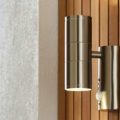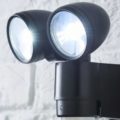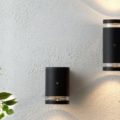Darker evenings mean it is more important than ever for households to have the appropriate lighting installed in their outdoor spaces. While summer is the perfect time for ornamenting your garden with decorative solar lamps and light strings, you should have a good outdoor floodlight installed during the winter months, for additional safety and security.
There is a lot of variety when it comes to choosing the right outdoor floodlight or security spotlight, which can seem a bit daunting. Following these steps should make it easier to find the perfect one for you.
Location is everything
Before you even start looking for the right outdoor floodlight, determine where you’re going to install it. Most importantly, what area does the light need to cover? The height and angle at which the light is installed could make a big difference in how well it lights your chosen space.
Windows, doors, drainpipes and gutters may all be obstacles to finding the right placement, so it’s important to think about this early. When you have decided on the right spot, try and get an idea of the size of light that will fit in the space. It would be no good buying a high-powered floodlight, only to find that it’s too big to fit in the position you have chosen for it.
How do you want your outdoor floodlight to activate?
As lighting technology progresses, floodlights are becoming more sophisticated in how they are activated. In addition to the standard on/off switch that you can use to manually activate your light, you can also find floodlights with motion sensors, which will illuminate when someone (or something) passes in range of its sensor. Alternatively, ‘Dusk till Dawn’ floodlights automatically switch on when the ambient light falls to a certain level and then switch off again in the morning when the sun comes up.
Picking one of these options really depends on personal preference. Do you want a light that you can manually switch on and off yourself? The inherent risk with this is that the light will get left on during the day, wasting energy and reducing the life of the fitting. Motion sensitive lights are the most energy-efficient, as they are only illuminated when they need to be, but the sensor could cause the light to activate when animals pass by, or even when neighbours are out in their own garden. Some might find this disconcerting. Dusk till dawn lights present a happy medium, as they don’t need switching on manually and they will just stay on through the night.
Get the right brightness
Floodlights come in a broad range of brightness outputs, perhaps more than any other type of light. You can find floodlights that output anything between 700-20,000+ lumens (for more information about lumens, see our guide to lumens).
Which one you choose primarily depends on how big a space you need to illuminate. An outdoor floodlight with only a relatively low lumens output (700-1,500lm) will suffice for patios and driveways, while commercial spaces like car parks and small fields will obviously need high-powered floodlights that output many times that. There is no hard and fast rule for picking floodlights of a certain brightness, but below is a rough guide that may help.
| LED Wattage | Lumens | Typical Use | Area Covered |
| 5W | 400lm | Doorway | 5m x 5m |
| 10W | 750lm | Patio Area | 10m x 10m |
| 20W | 1,500lm | Driveway | 15m x 15m |
| 30W | 2,200lm | Small Garden | 20m x 20m |
| 50W | 4,000lm | Medium Garden | 30m x 30m |
| 100W | 8,000lm | Large Garden | 50m x 50m |
| 150W | 16,000lm | Parking Lot | 75m x 75m |
| 200W | 20,000lm | Car Park | 100m x 100m |
As mentioned before, placement and angle also make a big difference in how efficiently your outdoor space is lit. Getting these right will give you a little more room with the lumens output of your chosen floodlight. Conversely, if you know the light can’t be installed in a perfect position, you can take this into account when deciding on the brightness of the floodlight.
Upgrade to LED floodlights
Traditionally, most outdoor floodlights have used halogen light bulbs, which use 20-30% less energy than older incandescent light bulbs, but which come nowhere near LED light bulbs for their energy-saving potential. The biggest advantage of LED light bulbs, in this case, is their superior lifespan. Where a halogen light bulb might last around 2,000 hours, LED floodlights can last 30,000 hours or more. In addition to the cost-saving that this long lifespan provides, it means that you won’t have to go through the hassle of replacing your floodlight (or its light bulb) nearly as often. This alone makes for a good reason to upgrade to LED floodlights.
Be aware of your neighbours
Make sure the floodlight you’re installing isn’t going to cause a nuisance to your neighbours. The government advises that artificial light becomes a nuisance when it ‘unreasonably and substantially interferes with the use or enjoyment of a home or other premises’ or ‘injures health or is likely to injure health.’ An example would be where an artificial light shines directly into a neighbour’s bedroom window and disturbs their sleep.
Nuisance lighting can be reported to local councils, who will evaluate the complaint and serve an abatement notice if they do judge the light to be a nuisance. A little planning can avoid this entirely. Make sure the light is not unreasonably bright (see above) and not pointing directly into a neighbour’s property. In some cases, it might mean you can’t install the light exactly where you planned, but it will cause less hassle in the long-term and will help preserve a good relationship with your neighbours.





I needed the information on the specification of the distance and lumens so thank you! This was so helpful 😊😊😁😁😁!